墨西哥人脫貧,,要靠這種植物
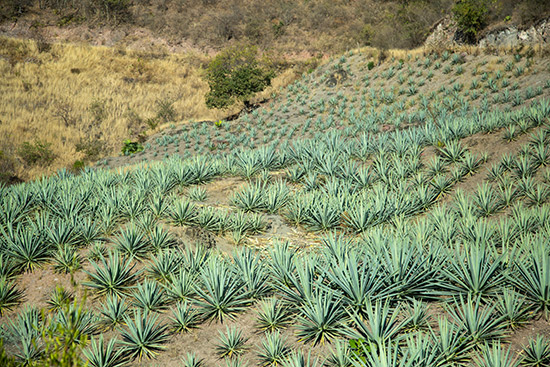
|
從博尼法西奧·克魯茲·魯伊斯臉上平靜的笑容可以看出,他很為自己種植的龍舌蘭感到驕傲,。 在魯伊斯家后院一個手工搭建的小溫室里,,架子上的烤盤里栽有成千上萬的龍舌蘭幼苗。每個烤盤上都有幾百棵幼苗,,有一天它們會長成重達(dá)幾百磅的巨型植物,。博尼法西奧小心翼翼地端著盤子,,就像抱著他的孩子一樣,從某種角度而言,,它們確實是他的孩子,。 后院的小苗圃是魯伊斯參與非營利組織“國際小母牛組織”(Heifer International)墨西哥瓦哈卡試點項目的成果,這是小母牛組織的第一個龍舌蘭項目,。該組織經(jīng)常向欠發(fā)達(dá)地區(qū)的人們提供雞和山羊等家禽家畜,。該組織來到魯伊斯的小鎮(zhèn),幫助那里的村民搭建龍舌蘭溫室,,向他們展示如何照料這些植物,。最近,魯伊斯又更進(jìn)一步,,將自己收到的禮物傳遞了出去——他也開始和附近的村民分享他種的秧苗,,告訴他們?nèi)绾握樟希屗麄円材軌蜻@樣照著種,。 |
You can tell by the quiet smile on his face that Bonifacio Cruz Ruiz is proud of his agave plants. Inside a small handmade greenhouse in his backyard, Ruiz has thousands of plants growing on shelves lined with baking sheets. Each sheet contains hundreds of small seedlings that will one day grow into massive plants weighing hundreds of pounds. Bonifacio carries the trays with care, as if they hold his children, and in a way, they do. The backyard nursery is the result of Ruiz’s work with nonprofit Heifer International, through its pilot program in Oaxaca, Mexico, Heifer’s first involving mezcal. The organization, which typically shares livestock such as chickens and goats with people in underdeveloped areas, came to Ruiz’s town and helped him and other residents build greenhouses for agave plants, showing them how to maintain those plants. Recently Ruiz was able to take things a step further and pass the gift along by sharing some of his beautiful seedlings, as well as directions on how to care for them, with neighboring villagers so they could do the same. |
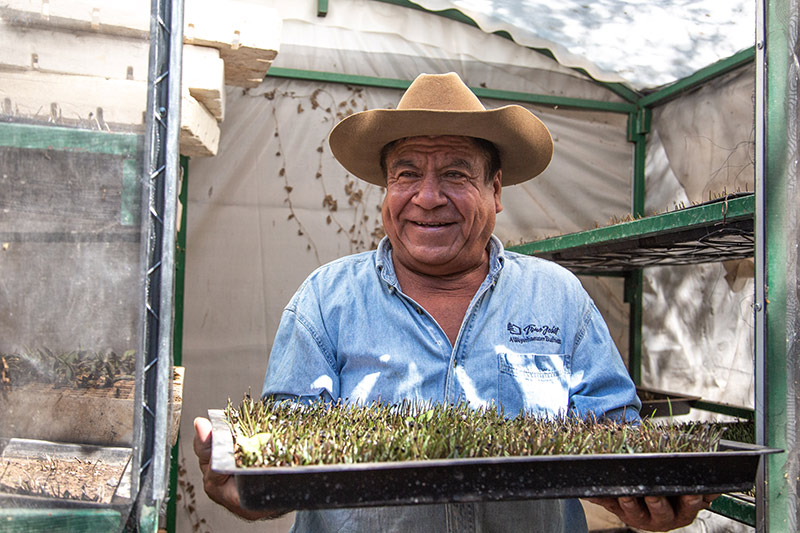
|
魯伊斯小心翼翼地把托盤放回原處,帶著我和小母牛組織的一小部分員工,,沿著他家后面大約半英里遠(yuǎn)的一條有點危險的小路走下去,。我們沿著山路上上下下,穿過一條小河,,來到一個小花園,,他把從烤盤上露頭的幼苗移栽到花園里。你可以從他的表情上看出,,他為自己的成就和未來的可能性感到驕傲,。 |
After he delicately puts the tray back in its resting place, Ruiz leads me and a small group of Heifer employees down a slightly treacherous path roughly a half a mile behind his home. The journey takes us up and down hills and across a small river to a small garden, where he transplants the seedlings once they’ve outgrown their baking-tray beginnings. You can tell by looking at his face that he’s proud of what he’s accomplished and what the future might hold. |
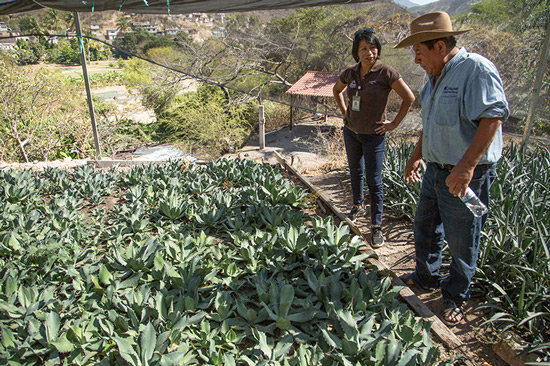
|
在圣安娜德爾里奧鎮(zhèn),,有一句諺語:“噩運(yùn)降臨時,,喝杯梅斯卡爾酒吧。好事發(fā)生時,,也喝杯梅斯卡爾酒吧,。”這句話的最佳搭配是手捧一杯當(dāng)?shù)蒯勗斓拿匪箍柧?,這種飲料在當(dāng)?shù)剡m用于一切場合,,從下午茶飲品到民間治療偏方,什么都可以,。 多年以來,,梅斯卡爾酒一直是當(dāng)?shù)厝藗兩钪胁豢扇鄙俚囊徊糠帧H欢?,在這個與世隔絕的小鎮(zhèn)上,,人們的家里連自來水和電等基本設(shè)施都很少有,,更別提讓梅斯卡爾酒取得商業(yè)成功了。他們也難以繼續(xù)保持當(dāng)?shù)氐膫鹘y(tǒng),,因為越來越多的年輕人離開這個地方,,去尋找更好的工作機(jī)會。許多人最終選擇移民到美國,。 以前村里用來制作梅斯卡爾的龍舌蘭是野生的,。然而,當(dāng)這些野生植物出現(xiàn)問題時,,當(dāng)?shù)卮迕癫坏貌粡钠渌迩f購買,,他們本就十分微薄的利潤就變得少之又少。而且野生龍舌蘭很難找,,采集夠做一批梅斯卡爾酒的龍舌蘭需要花費(fèi)很長的時間,。 現(xiàn)在,多虧了小母牛組織,,魯伊斯種的龍舌蘭不僅能夠確保當(dāng)?shù)乜梢該碛蟹€(wěn)定的龍舌蘭供應(yīng),,而且人們不必再花力氣四處尋找野生龍舌蘭。 2017年,,魯伊斯和村里的其他成員投票決定,,把他們的梅斯卡爾賣給小母牛組織的合作伙伴保樂力加集團(tuán)(Pernod Ricard),在此之前,,保樂力加的代表曾經(jīng)專程來村里考察,。當(dāng)時的計劃是最終要把村里的梅斯卡爾整合到公司頗受歡迎的Del Maguey品牌里。這還沒有最終實現(xiàn),,但保樂力加一直在收購儲備梅斯卡爾,,計劃在未來發(fā)布新品。 即使官方還沒有正式發(fā)布,,這種合作關(guān)系已經(jīng)取得了一些巨大成果。這個鎮(zhèn)子過去曾經(jīng)以每升8比索(約合50美分)的價格出售梅斯卡爾,,現(xiàn)在它的售價已經(jīng)接近130比索(約合7.5美元),,這是一個巨大的進(jìn)步。村民們的銷量也更高,。在小母牛組織和保樂力加參與之前,,羅德里格斯一家每年一般賣出400升。現(xiàn)在這個數(shù)字已經(jīng)接近1000升,。 小母牛組織希望能夠助力這種增長,,讓這門營生在這個家庭年收入平均在3000到5000美元之間的地區(qū)中更加持續(xù)。現(xiàn)在,,當(dāng)?shù)匾呀?jīng)能夠生產(chǎn)一種統(tǒng)一的產(chǎn)品,,而且意識到了這種酒的市場價值,。 除了教魯伊斯等人如何搭建溫室,如何培育幼苗,,該組織還幫助當(dāng)?shù)剞r(nóng)民學(xué)習(xí)技能,,例如怎么防止植物不受蟲害破壞(龍舌蘭往往需要5至7年才能成熟),如何照顧牲畜,、防止牲畜染?。ㄋ鼈兂S脕碓诙盖偷纳狡律像W載這些沉甸甸的植物)。 |
In the town of Santa Ana del Rio, there’s a saying: “Para todo mal, mezcal. Y para todo bien, tambien.” Translation: “For everything bad, mezcal. And for everything good, too.” It’s a saying best accompanied with a glass of the local spirit in your hand and commemorates a liquid that is used in the area for everything from an afternoon drink to a folk remedy to cure illnesses. Mezcal has been an integral part of the local community for generations. However, families in the isolated town—which has exceptionally limited access to basic utilities like running water and electricity—have had trouble making the spirit a commercial success. They’ve also run into trouble keeping the tradition going, as younger members of the community tend to leave the area, seeking greater job opportunities. Many ultimately choose to immigrate to the United States. The agave used to make mezcal in the village has traditionally been harvested from wild plants. However, when something happened to those plants, the village was forced to buy them from other villages, cutting into their already meager profits. Wild agave can also be hard to find, making the process of collecting enough for a batch of mezcal a rather time-consuming task. Now, thanks to Heifer, that agave Ruiz is growing will ensure the area has not only a steady supply of the plant, but also that they’ll be able to locate them quickly. In 2017, Ruiz along with other members of the village voted to sell their mezcal to Pernod Ricard, which is working with Heifer on the program, after a representative from the brand visited the area. The plan at the time was to ultimately integrate mezcal from the village into the company’s popular Del Maguey brand. That hasn’t happened just yet, but Pernod is consistently purchasing the mezcal and storing it with plans to release it in future. Even without the official release, that partnership has fueled some tremendous results. Whereas the town once sold its mezcal for just eight pesos a liter (approximately 50¢), it’s now approaching 130 pesos per liter ($7.50), a significant improvement. The villagers are also selling more. Prior to Heifer and Pernod’s involvement, the Rodriguez family typically sold around 400 liters of mezcal per year. Now that number is closer to 1,000 liters. Heifer wants to help facilitate that growth, making the industry more sustainable for a community where the average annual family income is between $3,000 and $5,000. Now the community is making a consistent product and is aware of the spirit’s market value. Beyond teaching Ruiz and others how to build greenhouses and nurture seedlings, the group also helps local farmers learn skills such as how to prevent pests from destroying the plants, which can often take five to seven years to reach maturity, and how to care for and prevent diseases in their livestock, which are often used to harvest those heavy plants on the steep hills where they grow. |
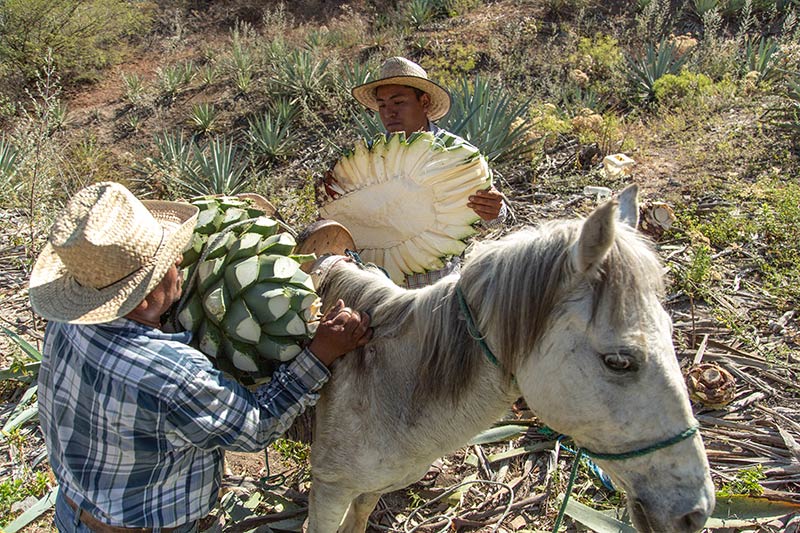
|
西羅·羅德里格斯是村里負(fù)責(zé)收割龍舌蘭的人之一,。每一天,他和兩個兒子都頂著烈日勞作,,收割龍舌蘭,,這種植物通常重幾百磅,他們用大砍刀切掉堅硬的龍舌蘭葉,,再把龍舌蘭中間的芯(pi?a)運(yùn)回家里的戶外蒸餾室(稱為palenque),,把龍舌蘭釀成梅斯卡爾。 這項工作非常熱也非常累,,哪怕是對于一個沒有動一下手指也沒有背任何重物的旁觀者來說都是如此,。這種植物通常生長在陡峭難以通行的山坡上,它們被綁在驢背上,,沿著塵土飛揚(yáng)的山丘上上下下,。 “小母牛組織為我們的馬、騾子和驢子提供了疫苗,?!绷_德里格斯說,“這對我們幫助很大,?!?/p> 收割龍舌蘭需要人工進(jìn)行,而且一次只能夠采摘一棵,,最后才可以把龍舌蘭的芯裝上卡車,,運(yùn)回鎮(zhèn)上。 |
Ciro Rodriguez is one of the people responsible for harvesting agave in the village. Each day he, along with his two sons, labors in the sweltering sun, harvesting the agave plants, which can often weigh hundreds of pounds, and then cutting off their tough leaves with machetes before carrying the heart of the plant—the pi?a—back to their family’s outdoor distillery, called a palenque, to be turned into mezcal. It’s exceptionally hot, laborious work, even for an onlooker who isn’t actually wielding any tools or bearing any heavy loads. Plants often grow on steep, hard-to-navigate inclines, and they’re carried up or down these dusty hills, strapped to the back of the family’s donkeys. “Heifer has provided us with vaccines for horses, mules, and donkeys,” Rodriguez says. “That has helped us a lot.” Once the agave is harvested, a process that’s done by hand one plant at a time, the pi?as are eventually loaded into the family’s truck and then driven back into town. |
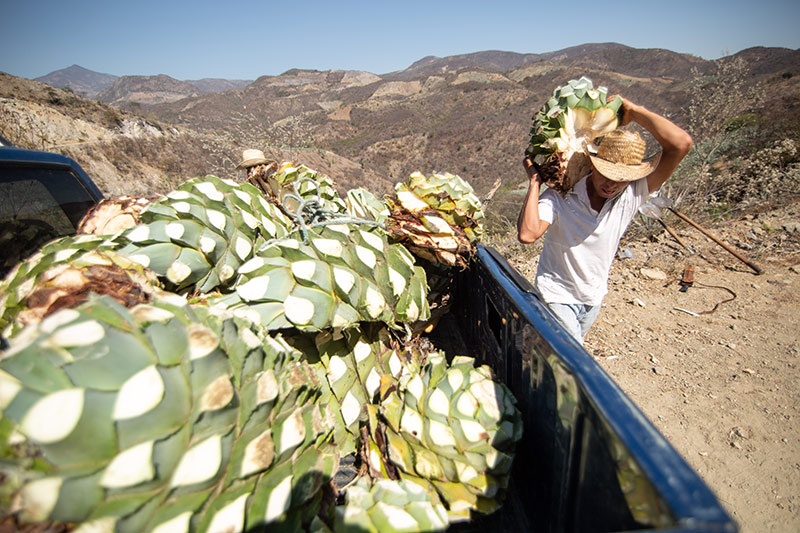
|
在鎮(zhèn)上,,這些植物被放置在一個填滿熱石頭的大土坑里。上面鋪上泥,,烘烤大約一個星期,。之后,人們把這些龍舌蘭芯進(jìn)行人工壓榨,,纖維會放在小蒸餾器中,,最后被蒸餾成梅斯卡爾,。 |
In town, the plants are placed in a large dirt pit filled with hot stones. Dirt is put on top, and the plants are cooked for roughly a week. Afterward, those pi?as are manually pressed, and the fibers are placed in small stills where they’re distilled into mezcal. |

|
這是一個漫長的過程,。所有流程都需要在超過100華氏度的室外高溫環(huán)境下完成,,使得原本就很辛苦的工作變得更加困難。它的制作方式也和村子里世代相傳的做法非常相似,。 目前,,梅斯卡爾只散裝銷售,銷售的產(chǎn)品符合保樂力加設(shè)定的質(zhì)量標(biāo)準(zhǔn),。羅德里格斯說:“如果我們想把梅斯卡爾進(jìn)行灌裝,,那就意味著要把很多錢付給當(dāng)局來獲得許可?!蹦鞲绲木祁愪N售稅很高,,有時高達(dá)60%,因此很難依法銷售,。 |
It’s a long process. And all these tasks are also performed outdoors in temperatures topping 100 degrees, making an already laborious process even more so. It’s also done in very much the same way it always has been from generation to generation in the village. For now, that mezcal is only sold in bulk, and what is sold is made in a way that it meets quality standards Pernod has set in place. “If we wanted to bottle the mezcal that would mean a lot of money to pay to the authorities and to get permission,” Rodriguez says. Liquor sales in Mexico have high taxes, sometimes near 60%, which can make it hard to market the product in accordance with the law. |
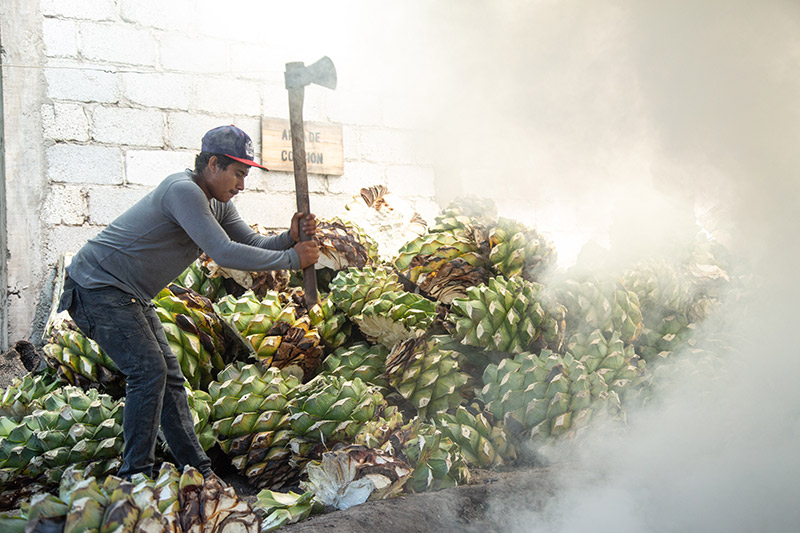
|
現(xiàn)在,,這個村子和它的梅斯卡爾生產(chǎn)可以為當(dāng)?shù)鼐用裉峁┠軌蚝诘氖杖耄藗兿M梢杂懈嗟娜诉x擇留在這里,,繼續(xù)傳承這些傳統(tǒng)——同時也希望把這門生意進(jìn)一步發(fā)揚(yáng)光大,。 “繼續(xù)前進(jìn)。這就是我們現(xiàn)在需要做的,?!绷_德里格斯說,“我們希望梅斯卡爾的生產(chǎn)能夠繁榮發(fā)展,。我們過去種植龍舌蘭和制作梅斯卡爾只是為了種而種,,沒有得到任何改善或進(jìn)步。現(xiàn)在我們想擁有自己的品牌,?!?span>(財富中文網(wǎng)) 譯者:Agatha |
Now that the village, and its mezcal production, can provide a living wage for its residents, the hope is that more of them will choose to stay in the area and keep those traditions going well into the future—and potentially grow the business further. “Continue getting ahead. That is what we’re looking for right now,” Rodriguez says. “We would like the mezcal production to thrive. We used to plant agave and make mezcal just because, without seeing any improvement or progress. Now what we want is to have a brand of our own.” |













